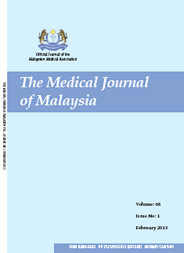MJM, Vol 70 Supplement 1 September 2015
Factors of Leptospirosis preventive practices with
spatial mapping of Knowledge, Attitude and Practice among residents in
Perkampungan Sungai Isap, Kuantan
ABSTRACT
Background: Leptospirosis is a preventable zoonotic disease of public health importance. Due to seasonal floods affecting Kuantan community, a study was conducted to determine the factors associated with leptospirosis preventive practices with spatial mapping of knowledge, attitude and practice using Geographical Information System (GIS).
Methodology: A cross-sectional study was carried out in Perkampungan Sungai Isap, Kuantan, Pahang, which obtained 568 respondents by stratified proportionate random sampling technique. Data was collected using a validated guided questionnaire, comprising of sociodemographic status, knowledge, attitude and preventive practice towards leptospirosis. Geographical coordinates were obtained using Garmin. Data analyses were done using SPSS version 22.0 and ArcGIS version 9.
Results: The response rate was 83.4%. The respondent’s median age was 29 years old (IQR: 25). The median income for earners was RM1500 per month (IQR: 1500), Majority of the respondents were female (52.6%), Malay (98.8%), attended up to secondary school level (57.2%), worked in a low-risk occupational group (96.0%) and reside in moderate risk stratum (55.6%). The spatial distributions of knowledge, attitude and practice were successfully plotted. Overall, majority (68%) of the respondents had good knowledge. However, only 38% of the respondents had satisfactory attitude and 18% had satisfactory practice. There was significant association between stratum and leptospirosis preventive practices (p=0.003), age group and leptospirosis preventive practices (p<0.05) and personal income and leptospirosis preventive practices (p<0.05). Knowledge significantly associated with attitude towards the disease (Odds Ratio 3.18, 95% CI: 2.11-4.78). Multivariate logistic regression showed the predictors of satisfactory leptospirosis preventive practices were high risk stratum, good knowledge and age group 30 to 39.
Conclusion: Leptospirosis can be prevented by having adequate health promotion campaigns as well as controlling external factors such as improving drainage system and access to healthcare facility with the help of GIS.
Keywords: Leptospirosis, preventive practices, factors, floods, Kuantan, GIS
